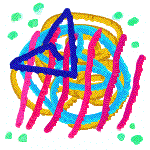
| ARTDEAL / WHAT'S NEW ? / ESSAYS / FEATURES / INTERVIEWS / SURVIVAL / ARTIST INDEX / CONTACT |
The Poetry of Abstraction
It took me some time to come to abstract painting, to the far side of it,
to that place where the language smells sweetly vague, where the space is
free. These are the still pure waters of a once frontier art, an experience
otherwise shared only by music, and sometimes poetry. Every once and a while
I stray back over to the other side, back to representation, where things
can seem more definite; but it doesn't last long, not more than a canvas,
and lately I have wondered why.
The danger here, of course, is to compare. Do I really want to resurrect
that old confrontation, that mean and meaningless one that has been mercifully
put to rest in this postmodern era? No. I want to pay homage to abstract
painting, that's all. I want to tell you what it has meant to me.
Now bear in mind that abstraction has its price, and I have paid it. It
is easy to wake up one day and wonder just where in all that music and poetry
we stand, if we are present? That's important, because the work has to rest
on our shoulders, the shoulders of our voice and experience. We have to
be minding the store, and if we are absent, if we've wandered off, or crawled
away to hide, then the work is likewise vacant.
I've had various experiences with abstract painting since I was a child.
The most important was with the work of the New York second generation abstract
painter, Milton Resnick. We had one of his paintings in our home and I must
have looked at it every day. And every day it was different. I have the
painting still, and I have never cornered it, not that I try. It is like
a plant that gives fresh blooms each morning; but the effect is stranger
still, as though it were inhabited by some kind of energy, some gentle,
untamed animal, never to be still. I have a deep affection for this painting,
and it nourishes me like a home.
Just about the time that I was through with art school I wandered into a
show of Richard Tuttle's tiny abstractions at Brown University's List Art
Gallery. I was completely rocked, completely blown away. As much as these
works were about all the deeper experience of this artist, about hope and
despair, joy and pain, love and hate, what struck me hard and fast was all
of the freedom and possibility. His funny little squiggly wall drawings
were like kites to me, flying high above an artworld mired in issues of
posture, image, and style. Tuttle's work seemed as true and unencumbered
as a poets. I have never admired an artist more.
While in New York in the late Seventies and early Eighties I was turned
on to the work of Forest Bess, Bill Jensen, and Leon Polk Smith by my friend
and fellow young painter, Doug Welch. Bess was long dead, Jensen was launching
a comeback from his burned out and heavily fortified Williamsburg studio,
and Smith was like some ancient bald eagle, perched high up in his Union
Square loft. Each of these abstractionists made a huge impression on me:
Bess for sheer wayward funk in small paintings like mud pies, Jensen for
his tattooed images with all their Blake-like fire, and Smith for his jaunty
flying shaped canvases. It is from this last artist, this giant, now over
ninety years old, that I learned the poetry of abstraction.
Welch had recommended that I go over to Washburn to see Smith's latest show.
It must have been 1980, and I had never heard of him. I walked into the
tall Soho gallery and it was empty save for what seemed like an installation
from the Future pavilion at the World's Fair. Smith's towering forms were
at once elegant and awkward, poised, moving when my back was turned, pushing
out and up, like rockets and skyscrapers. And it was true, really, because
Smith is a self-appointed ambassador for the modern age. He loves it. In
it he found the freedom to explore space, and he did it using line, flat
colored shapes, and a poet's sensibility. What really did it for me, what
made it click, was that Smith never once proclaimed any kind of doctrine;
he let his work out in the open, to be itself, to speak for itself, unaffiliated,
unfortified, unexplained. All he said was, "You can't explain a painting.
It explains itself, if you give it a chance."
Although none of these artists has directly influenced my work, each of
them did something for me that I keep inside, what my friend, the always
inspiring Boston painter, Todd McKie, recently called "giving courage"
when he saw a work that touched and surprised him. That is the thing about
Leon Smith: every single time that I have visited his studio over the last
fifteen years I have been knocked off my feet by the most recent paintings.
It has always been a threshhold experience; I have literally left the ground,
awestruck, dizzied, floating in wonder, in space, in the poetry of abstraction.
Addison Parks
| ARTDEAL / WHAT'S NEW ? / ESSAYS / FEATURES / INTERVIEWS / SURVIVAL / ARTIST INDEX / CONTACT |